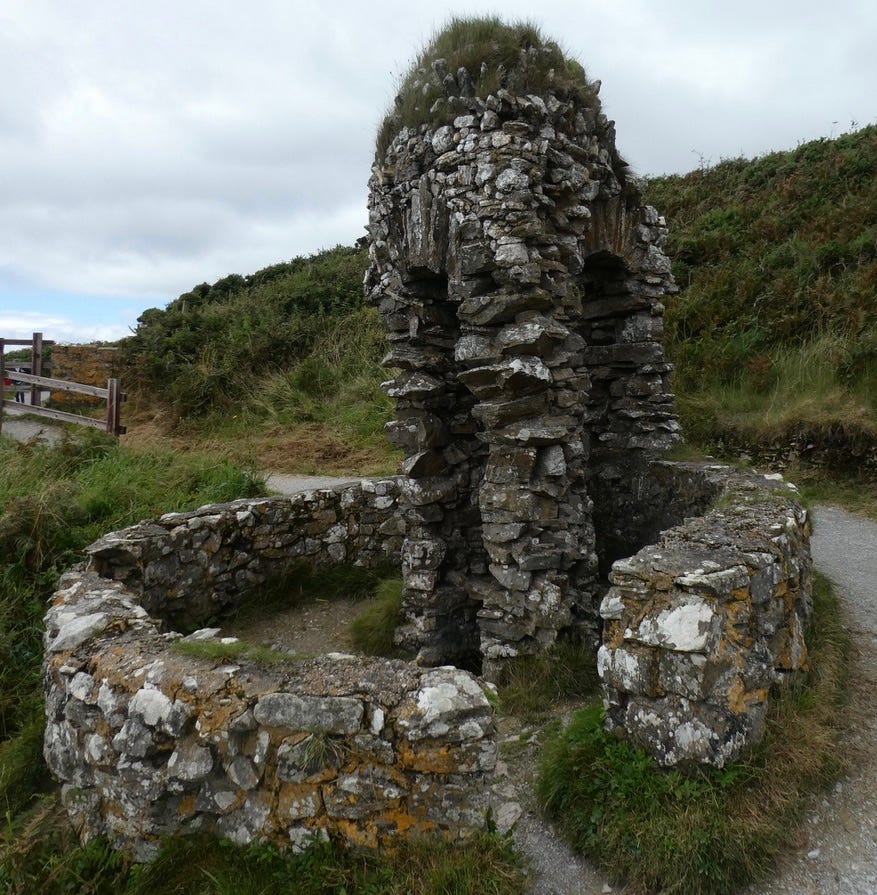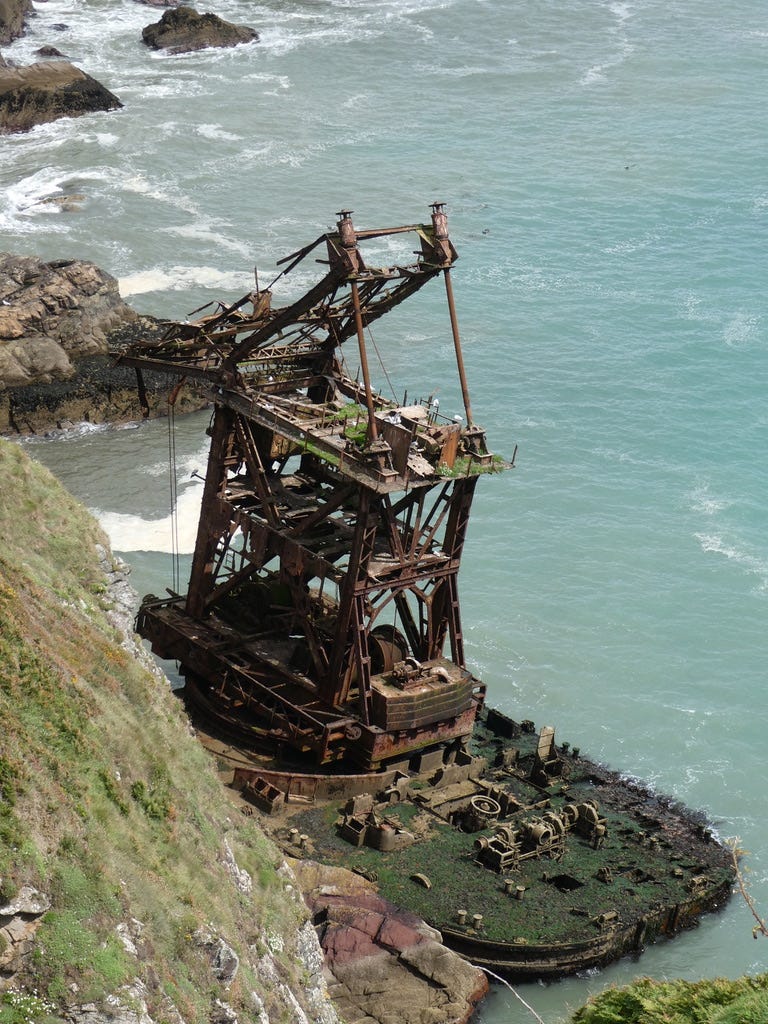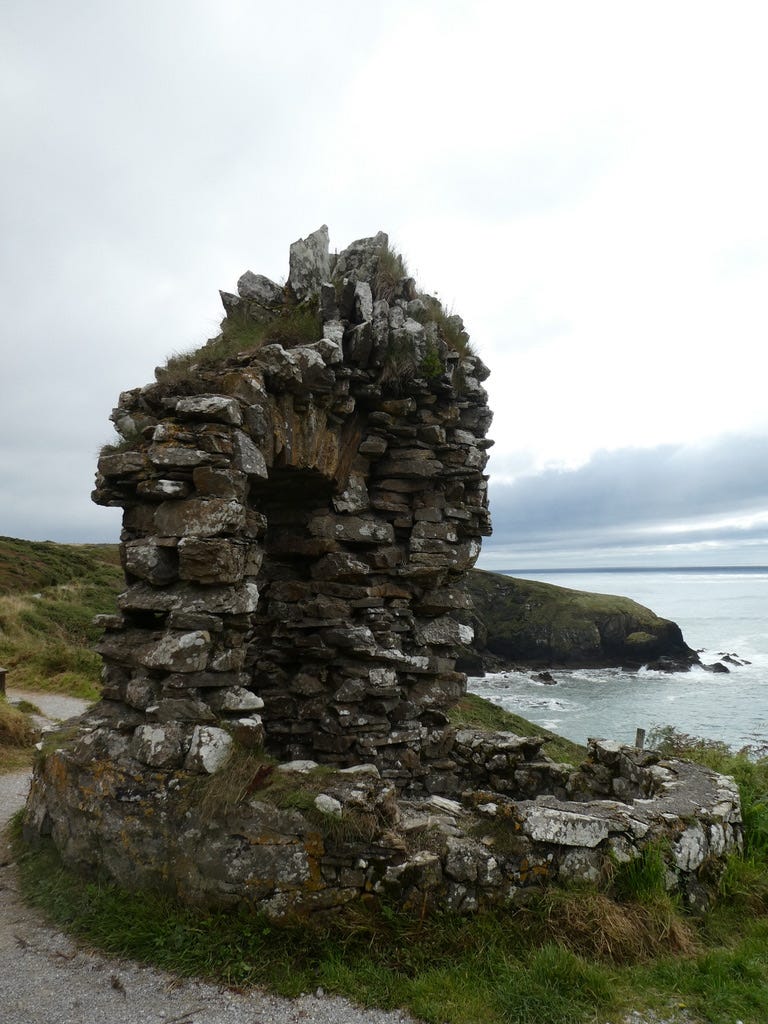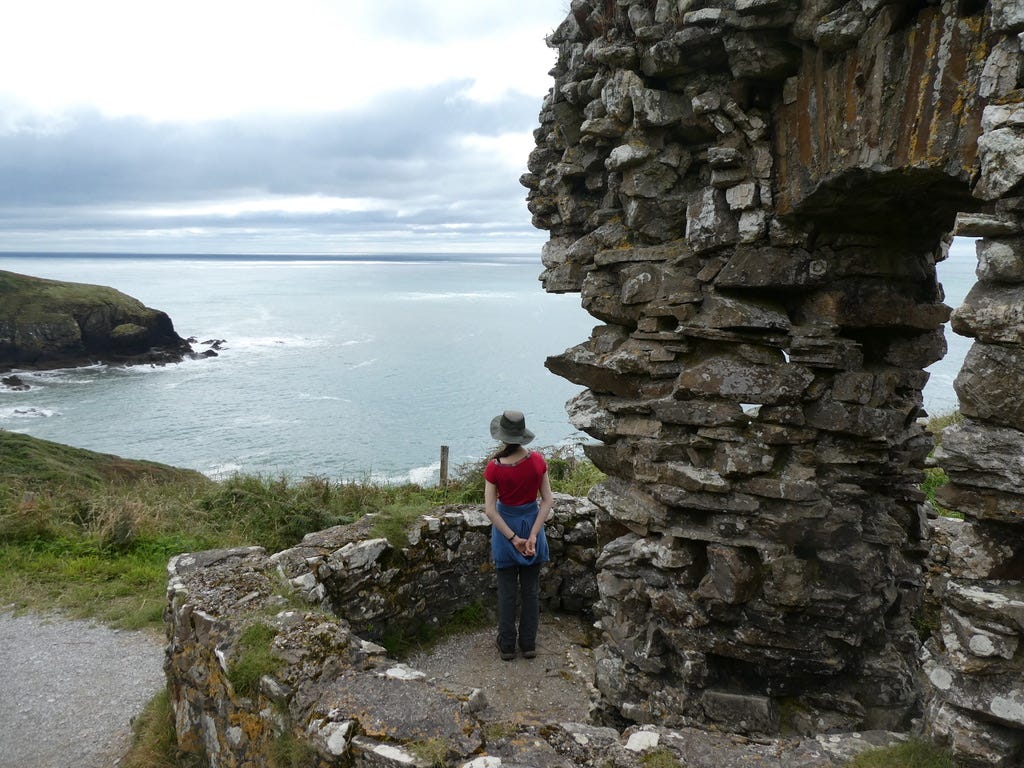Father O’Donnell’s Well, Ardmore, County Waterford
The cliff walk that begins in the little town of Ardmore, in County Waterford, on Ireland’s south coast, is a good way to spend an hour on a summer’s day. It packs a lot into a few miles. Start off in the town itself, and you’ll find yourself ambling over the cliffs, past a coastguard station that once played host to republican fighters during the Irish independence campaign, and then past an earlier Martello Tower, built to fend off any Napoleonic attacks a century before. The cliffs will sometimes open up before you, black and sheer down into the Atlantic. Seabirds wheel about, when they’re not nesting on the faces. The cormorants, especially, find it an excellent location to dry their wings in the sun:
The coastlines of Britain and Ireland, especially in the south of both countries, are tourist-ridden spots. It’s all beach spades and ice creams and birdwatching now, but it wasn’t so long ago that everything was utterly different. Step back even a century and these cliffs were home to industrial copper mines, when they weren’t being occupied by revolutionary soldiers. A century before, they were lined with British troops fearing a French invasion fleet.
Go back even further, and you find yourself in a time in which the greatest fear for small seashore villagers was slave raids. We’ve been hearing plenty in recent years about the European slave trade in Africa, but the African slave raids that blighted Europe for centuries are less well known. Between the sixteenth and the nineteenth centuries, by some estimates, over a million Europeans, many from villages like Ardmore, were captured and sold into slavery by the Barbary pirates of North Africa. In 1631, in one notorious example from Ireland, the entire village of Baltimore in County Cork was captured in a night-time raid and shipped off to the slave markets of Algiers. Something to think about the next time you buy an ice cream from the beach kiosk.
I’m digressing. The point is that this three mile walk has plenty of layers of history to offer (a secondary point might be that peaceful times rarely last, so we might as well enjoy them while they do.) About halfway around, for example, peering over the cliff edge will reveal the wreck of the Samson, a crane barge which ran aground in a storm in 1987, and which today provides a great nesting site for gulls and terns:
Not much further around, then, when you suddenly come across an odd stone construction slap bang in the middle of the path, you wonder what on Earth it is - or was:
It looks like a ruined building. But what kind of building? And why does the little circular wall around it seem to be intact while the archway looks half-built?
Peer inside, and you’ll notice something unexpected: a water channel. It rises directly at the centre of the circular enclosure, and is then funnelled down a stone trough and over the edge of the cliff. It doesn’t look like anyone cleans the trough very often:
What looks, at first sight, like a ruined house or church is in fact a wellhouse, built almost on the edge of the cliff itself, more than a mile out of town. What is it doing here? It doesn’t look like a holy well in Ireland usually looks - though it has a much better view than most of them.
This little construction is known locally as ‘Father O’Donnell’s well’, though Father O’Donnell himself is lost in the mists of time. The story goes that he was a priest who, for some reason, was prevented from serving in the church, and so used to come to this spot every day instead to read the Hours. He came here because there was already a spring here, known as a holy well and renowned for healing various ailments, especially those of the eyes. There has, it seems, never been any saint attached, or any rounds made, but those who drank the waters remarked on their healing properties.
One of those who was particularly impressed was a Mr J.P. Rahilly, who came to Ardmore in 1928 to recuperate from an illness. So convinced was he of the well’s healing properties, that he decided to spend some money he had apparently recently won on the horses, on building a suitable wellhouse. With permission from the landowner, and the help of some local men, the enterprising J.P. carted the stones up to the well himself, and, according to a local historian, set about the work:
J.P. did all the actual work himself, deepening the channel leading from the well, lining it and the well with white rounded stones and the building of the edifice now surmounting the well. He had ready local helpers in quarrying out the stones nearby … He planted rose trees all around and planned to have the whole surmounted by a Star of the Sea. He was to get an axle of a cart wheel from Tommie Moloney in the local forge, embed it in the wall and the wheel would revolve and be lighted at night. Tommie Moloney has memories of J.P. working away at his project, humming to himself all the time.
Alas, J.P.’s vision was never to be fully realised. Passing by one day, and spying the workers, on a break from their labours, imbibing some alcoholic refreshments, a local busybody complained to the local priest, who promptly withdrew his support for the project before it was complete. J.P. was forced to abandon his building work, and his vision for the well. And so the architecture of Father O’Donnell’s well remains, nearly a century on, frozen in time and incomplete, with poor J.P’s ambitious plans unfulfilled.
But perhaps it was better this way. This is a coastline of ruins, after all.











I know it was an aside, but thanks for mentioning the Irish stolen by Africans to be slaves.
Here in the U. S. we have it drummed into us that slavery is something us awful White Americans did to Blacks ... and us Whites should still feel guilty about and do reparations. We are rarely told slavery was something any number of peoples did to any other number of peoples -- and sadly still happens today. I'd wager most in the West and in Africa have in their bloodlines both slaves and enslavers.
Heck, somewhere sometime I surely have a relative who was enslaved. Where are my reparations?
Thank you Paul. It's funny how each of these little essays takes the reader off in an unexpected direction.